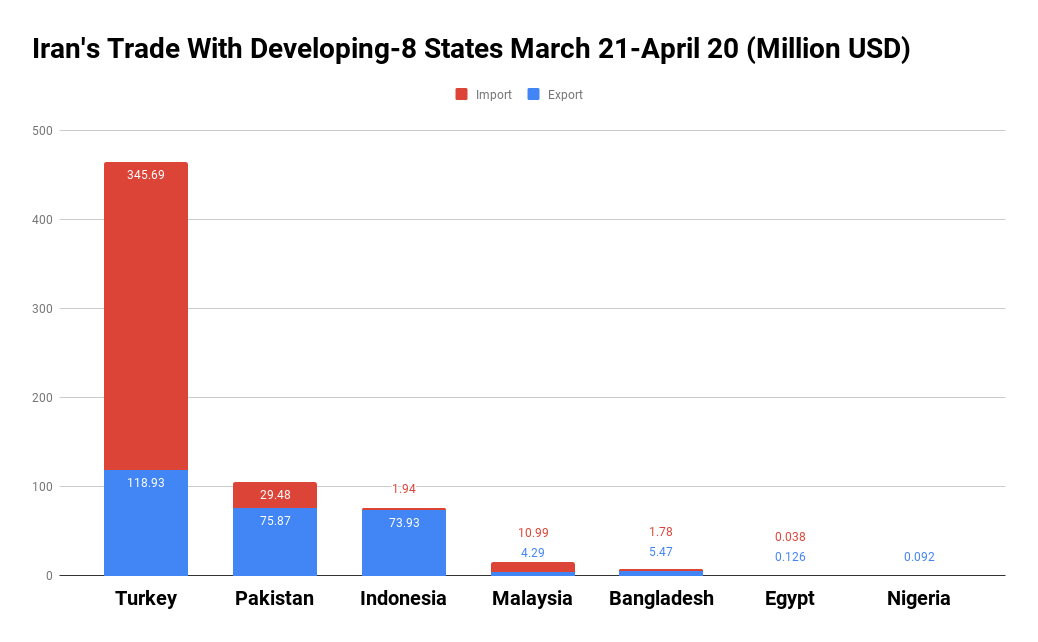Latest data released by the Islamic Republic of Iran Customs Administration show Iran’s exports totaled 728,814 tons worth $278.72 million during the month to April 20, indicating a 21.12% and 16.52% declines in tonnage and value respectively year-on-year.
Imports stood at 265,919 tons worth $389.94 million, up 143.85% and 125.41% in tonnage and value respectively YOY.
As a result, Iran recorded $111.22 million in non-oil trade deficit with D-8 states, Financial Tribune reported.
The D-8 Organization for Economic Cooperation, also known as Developing-8, is an organization for development cooperation among the following countries: Iran, Bangladesh, Egypt, Nigeria, Indonesia, Malaysia, Pakistan and Turkey.
The D-8 objectives are to improve member states' position in the global economy, diversify and create new opportunities in trade relations, enhance participation in decision-making at the international level and improve standards of living. It is a global arrangement rather than a regional one, as the composition of its members reflects.
The forum has no adverse impact on bilateral and multilateral commitments of the member countries, emanating from their membership to other international or regional organizations. The combined population of the eight countries is about 1 billion or 60% of all Muslims, or close to 13% of the world's population and covering an area of 7.6 million square kilometers, 5% of world land area.
Main Commodities, Trading Partners
Iran mainly exported non-alloy semi-finished iron/steel products, urea, bitumen, non-alloy zinc, non-alloy iron/steel ingots, hydrocarbon gases, polyethylene film grade and copper to D-8 states.
In exchange, major commodities imported into Iran from D-8 nations included butter, machinery parts, field corn, semi- and wholly-milled rice, cooking bananas, sheep, wood pulp and cotton.
In terms of trade value, Turkey topped the list among D-8 countries with Iran trade standing at 491,247 tons worth $464.63 million, up by 76.76% and 77.76% in tonnage and value respectively YOY.
Exports to Turkey amounted to 357,764 tons worth $118.93 million to register a 27.79% rise in tonnage and 7.33% decline in value YOY.
Turkey was Iran’s top export destination among the countries under review and sixth in the whole world.

In return, Turkey exported 233,483 tons of commodities worth $345.69 million to Iran, up by 206.38% and 159.84% in tonnage and value respectively YOY.
Turkey was the top exporter of goods to Iran among D-8 states and second in the world after China.
Major Iranian commodities exported to Turkey were urea, non-alloy zinc, polyethylene film grade, copper and aluminum.
In return, Turkey mainly exported butter, machinery, field corn, cooking bananas and sheep to Iran.
Pakistan was Iran’s second biggest trading partner among D-8 nations during the period under review, as two-way commercial exchanges stood at 229,735 tons worth $105.36 million, indicating a 10.53% and 22.27% increase in tonnage and value respectively YOY.
Iran exported 207,579 tons worth $75.87 million, up 9.42% and 13.3% in tonnage and value respectively YOY.
Pakistan was Iran’s second export destination among D-8 countries and eighth in the world during the one-month period.
Iran’s exports to Pakistan included bitumen, hydrocarbon gas, low-density oils, liquefied propane and fruit juice.
Iran imported 22,156 tons worth $29.48 million, up by 22.05% and 53.53% in tonnage and value respectively YOY, which mainly consisted of semi- and wholly-milled rice, cow, sesame seeds, beef and cans.
Pakistan was the second exporter of goods to Iran among neighbors and 13th exporter to Iran.
Indonesia was Iran’s third major trading partner among the states under review.
Mutual trade between Iran and Indonesia amounted to 192,059 tons worth $75.87 million, down by 13.64% and 30.19% in tonnage and value respectively YOY.
Iran’s exports reached 190,664 tons worth $73.93 million to register an 11.69% and 25.93% declines in tonnage and value respectively YOY, while Indonesia’s exports to Iran were at 1,395 tons worth $1.94 million, down by 78.55% and 78.08% in tonnage and value respectively YOY.
Indonesia was Iran’s third export destination and held the same rank as exporter of goods to Iran among D-8 states. The country was Iran’s ninth export destination and 20th exporter to Iran in the world.
Non-alloy semi-finished iron/steel products, non-alloy iron/steel ingots, radar devices and bitumen were Iran’s exports to Indonesia, while Indonesia exported coconut, paperboard paper, natural rubber, coffee and palm oil to Iran.
Highest Growths, Declines in Trade
Trade with Nigeria ($92,668), Turkey ($464.63 million) and Pakistan ($105.36 million) saw growths of 3,937.82%, 77.76% and 22.27% respectively YOY, while trade with Egypt ($165,633), Indonesia ($75.87 million) and Bangladesh ($7.25 million) witnessed the lowest declines of 99.29%, 30.19% and 28.89% respectively.
Iran’s exports to Nigeria ($92,668) and Pakistan ($75.87 million) saw growths of 3,937% and 13.3% respectively YOY, while exports to Egypt ($126,946), Malaysia ($4.29 million) and Bangladesh ($5.47 million) witnessed the lowest declines of 99.45%, 41.59% and 32.6% respectively.
Imports from Turkey ($345.69 million), Pakistan ($29.48 million) and Malaysia ($10.99 million) witnessed the highest rise of 159.84%, 53.53% and 13.25% YOY respectively, while imports from Indonesia ($1.94 million), Egypt ($38,687) and Bangladesh ($1.78 million) witnessed the highest declines of 78.08%, 41.26% and 14.48% respectively YOY.


